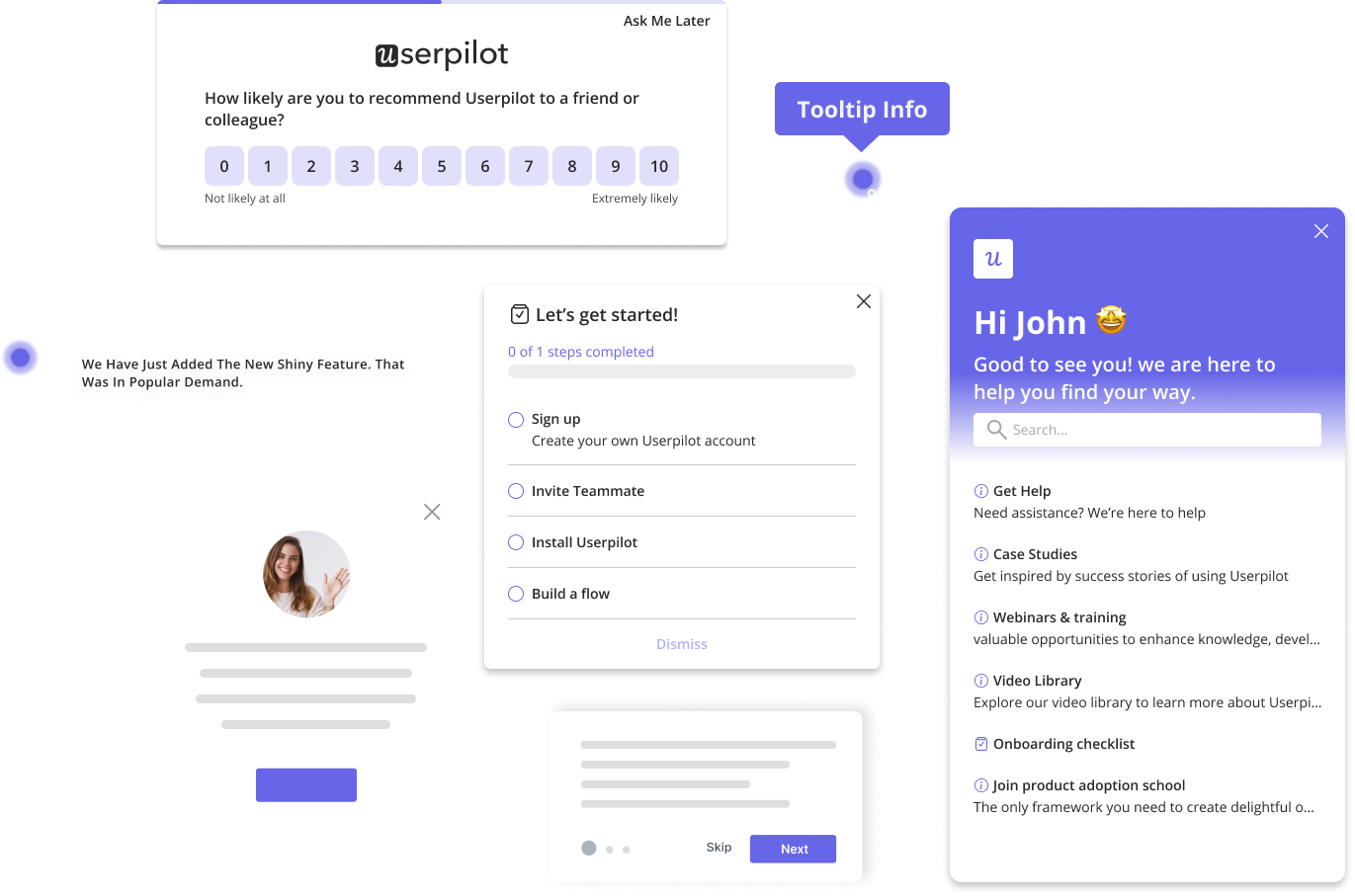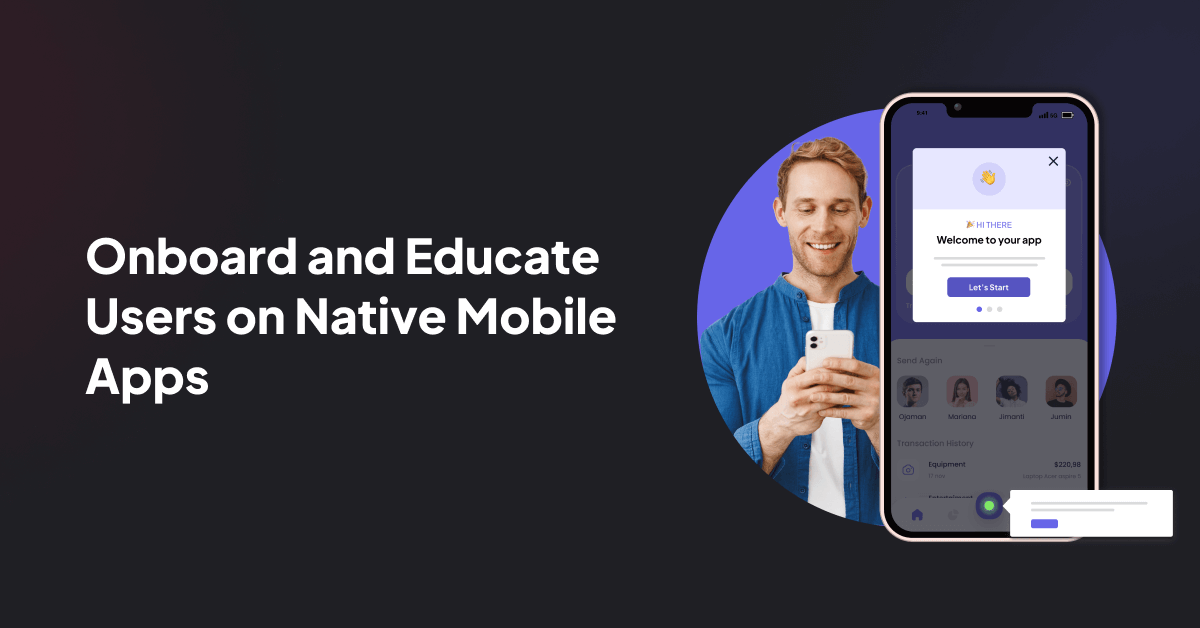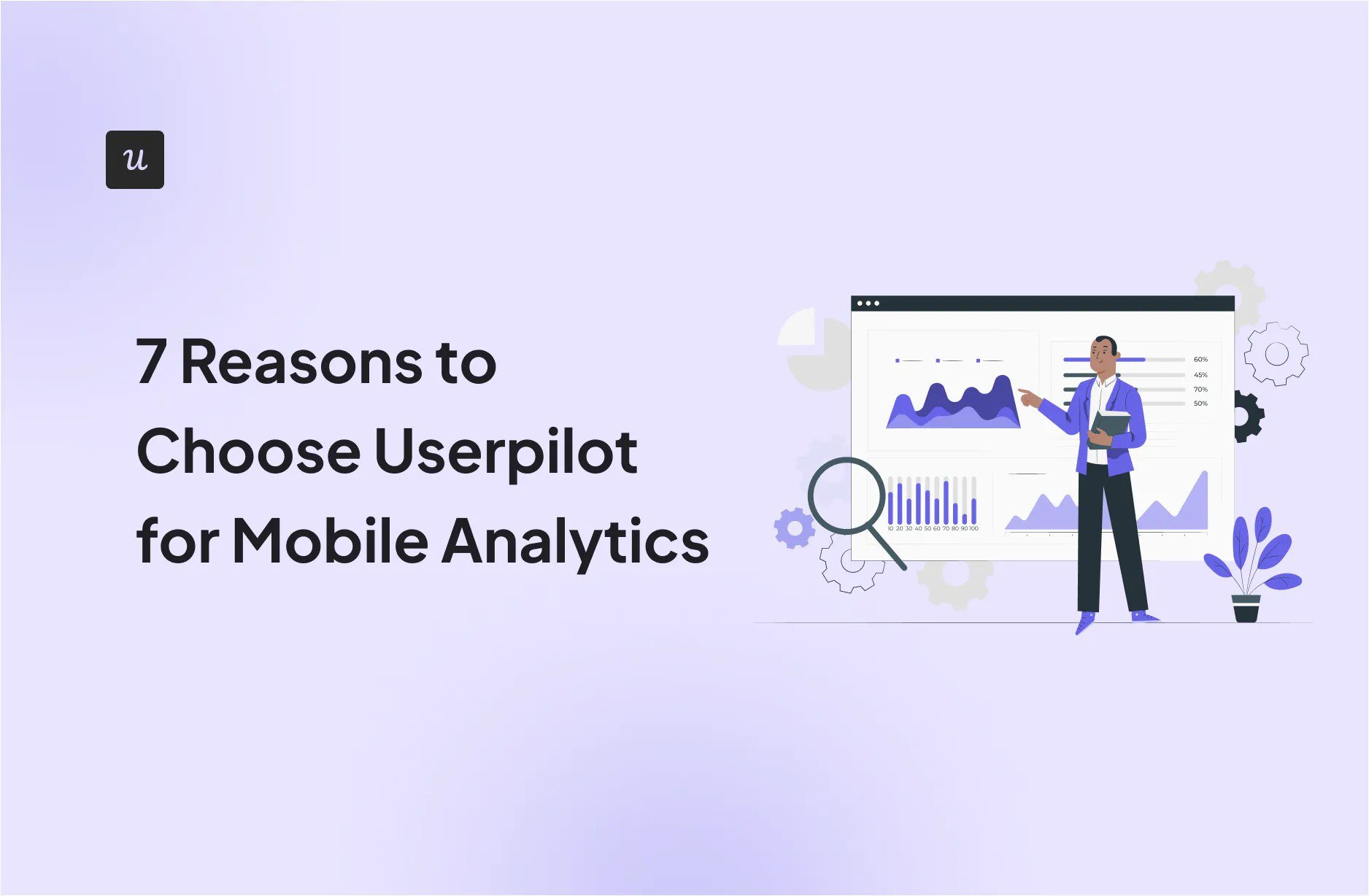
Let’s face it: understanding what your users are actually doing in your mobile app can be a real headache. As a fellow PMM who’s been there, I can tell you that traditional analytics tools just don’t cut it anymore.
That’s where Userpilot’s mobile analytics come in. It’s built for product people who need clear insights without drowning in data.
In this article, I’ll show you how Userpilot helps product teams cut through the noise and understand what really matters in mobile user behavior: no data science degree required.
Try Userpilot Now
See Why 1,000+ Teams Choose Userpilot
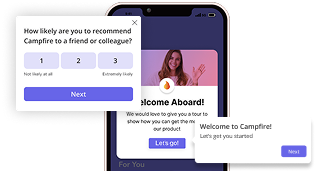
Userpilot for mobile analytics
Userpilot’s mobile analytics solution helps product teams understand user behavior and improve their mobile app experience without complex implementation. The platform delivers actionable insights that drive product decisions without requiring technical expertise.
Key capabilities include segmentation, which allows you to group users based on behavior, demographics, or custom properties; custom analytics dashboards, which visualize the metrics that matter most to your team; and screen-level analytics, which show exactly how users interact with each part of your app.
Common use cases for mobile analytics include optimizing onboarding flows to reduce drop-off rates, identifying underperforming features that need improvement, personalizing the user experience based on behavior patterns, and making data-driven decisions for your product roadmap. The platform’s code-free implementation makes it accessible for product managers who want insights without constantly relying on developers.
Are You Getting the Full Picture of Your Mobile Users?
Mobile data shouldn’t live in a silo. To truly improve customer engagement, you need Userpilot mobile analytics to connect the dots between web and app behavior. Take this quick check to see if your stack is mobile-ready.
Do you have a unified view of user journeys across both your web platform and mobile app?
When you identify a friction point in your mobile app, how do you intervene?
How do you collect qualitative feedback (like NPS) from your mobile users?
Bridge the Gap Between Web and Mobile
Don’t lose users to mobile friction. Userpilot helps you unlock cross-platform insights and deliver personalized mobile experiences without code.
Why choose Userpilot for mobile analytics?
Userpilot combines web and mobile analytics in one place, so you can follow user journeys without juggling multiple tools. You can build custom dashboards, track real-time metrics, and eliminate user friction before it’s too late.
By gathering quantitative analytics data and user feedback, Userpilot shows a qualitative and quantitative view of what users expect from your product. Then you can tailor in-app experiences for each user.
Plus, with SOC-compliant security and a simple interface, anyone on your team can get started right away.
1. Unlock cross-platform insights
If your data lives in multiple places, it’s hard to see how web and mobile behavior fit together. You can follow real user journeys by tracking both in one system without piecing together separate dashboards.
By unifying web and mobile analytics, you can bridge data gaps, pinpoint platform-specific opportunities, and build experiences that resonate with the user, wherever they are. Seeing the full picture clarifies which product updates will impact engagement and revenue the most.
2. Create flexible datasets with custom dashboards and reports
If you want to determine whether users adopt specific features, you need the freedom to build reports and analytics dashboards that reflect your goals. Userpilot’s real-time analytics let you track behavior, feature usage, and engagement trends across web and mobile in one place.
This is especially helpful for marketing, product, and CS teams, which all prioritize different metrics. For instance, marketing focuses on user acquisition, whereas product looks at feature adoption.
You can tailor those dashboards to your team’s needs so that marketers, product managers, and CX leads can focus on what moves their metrics. You can build anything from an onboarding funnel report to a feature adoption report for your newest release; anything that helps you quickly make data-driven decisions.
Note: At the time of writing, this feature is still in development and will be available at the end of Q1 2025.
3. Monitor key metrics for instant insights and optimization with mobile screens
Ever wonder if your mobile UX retains users or makes them click away? Userpilot’s dedicated mobile screen dashboard shows you the top metrics right away, including stages of a user flow.
This helps you spot friction early, like a glitchy signup field or a poorly adopted flow, so you can improve before it leads to churn.
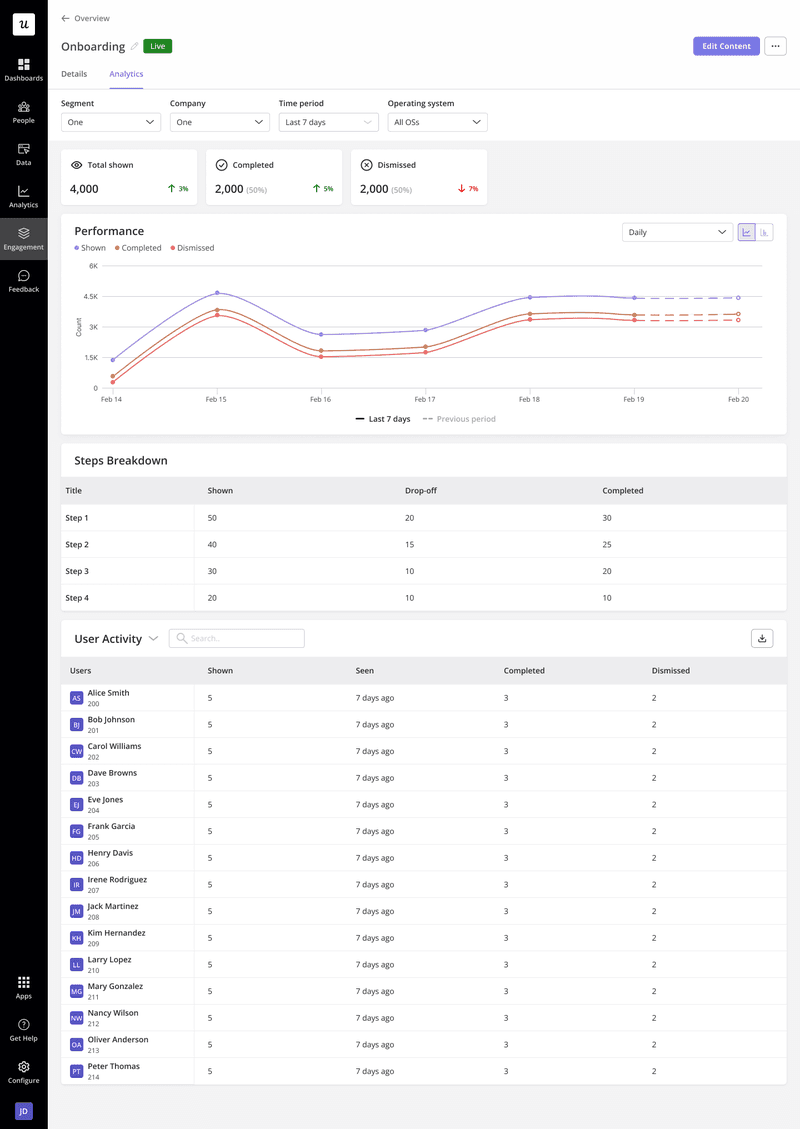
4. Deliver personalized experiences based on analytics
Once you know where people encounter friction and the features they engage with the most, you can act on that data by tailoring in-app prompts or walkthroughs to each user’s journey.
Our advanced user segmentation helps you create groups by actions or attributes, so if someone struggles with a specific feature, you can offer help at the right time.
This way, you don’t bombard everyone with the same tutorial. Instead, you match each experience to the user, which goes a long way toward sustaining user engagement.
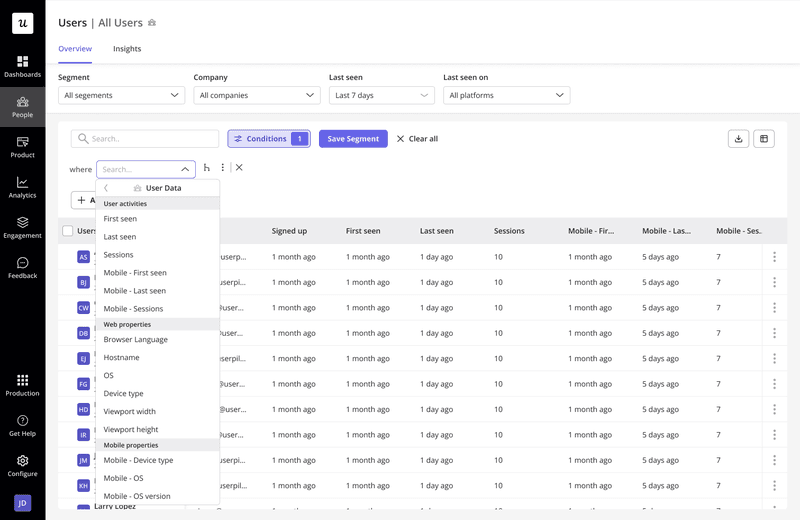
5. Unify quantitative and qualitative data to understand your mobile users
Many tools only give you vanity metrics like clicks, taps, or screen time without revealing how users feel. With Userpilot, you can set up event tagging and analytics to get quantitative data while running in-app surveys to learn why people do what they do.
Gathering both in a single place means you get more than numbers; you get context for user actions. It’s a far better alternative to managing extra tools that don’t give you the full story.
6. Protect customer data with the highest compliance standards
Every data point you collect represents actual people, so safeguarding it is a must. Userpilot’s data is fully encrypted and stored with SOC-compliant vendors like Amazon AWS and Google Cloud.
Keeping data protection front and center prevents data breaches, identity theft, phishing, etc., which can damage your brand reputation.
7. Benefit from Userpilot’s ease of use
Not every company has a dedicated engineering team ready to manage analytics and engagement tools. Userpilot’s interface is built for non-technical folks, so product managers, marketers, and CX teams can dive in immediately. As one of our customers put it:
“Great easy-to-use tool with good potential.
The greatest thing here is how easy it is to use. When taking over the processes related to Userpilot at my company, I could get into it in a few hours. Matching it with our data allows us to make personalized tours and get the most out of our product. Props to customer support who helps us resolve issues, spending time investigating issues, jumping on a call, great job.”
— Konstantin L., Mid-Market (51-1000 emp.) Computer Software Company
Market alternatives for mobile analytics solutions
When you’re investing in a mobile analytics platform, you’ll notice each tool has its pros and cons:
- Pendo offers sophisticated analytics and AI-driven insights, but the setup is more complex + it doesn’t provide iOS Push notifications.
- Appcues emphasizes in-app flows and spotlights but lacks NPS for mobile.
- Intercom focuses on messaging and help desk features, though it doesn’t offer NPS on mobile.
- Whatfix specializes in training and internal adoption but doesn’t include in-app notifications, so it repurposes the web UIs.
- WalkMe excels at enterprise-level digital adoption but has limited customization options for mobile.
| Feature | Userpilot | Pendo 🟢 | Appcues 🟢 | Intercom 🟠 | Whatfix 🔴 | WalkMe 🔴 |
| Supported Platforms | iOS, Android, React Native, Flutter, Ionic, Capacitor, (Cordova, Xamarin, Segment, Rudderstack coming soon) | iOS, Android, Xamarin, MAUI, React Native, Expo, Flutter, and Swift UI | iOS, Android, React Native, Flutter, Ionic | iOS, Android, Cordova, React Native | iOS, Android | iOS, Android |
| Onboarding & In-App Engagement | Carousels, Slideouts, Push Notifications | Carousels, Tooltips, Pop-ups, Guides | Flows, Spotlights, Banners, CTAs | Mobile Carousels, Messages, AI Bot, Help Centre, Push Notifications |
In-App Walkthroughs, Interactive Flows, Self- Help (like Resource C.) |
In-App Guidance, Walkthroughs |
| Push Notifications | ✅ | ❌ | ✅ | ✅ | ❌ | ❌ |
| Surveys (NPS, multi-choice, polls etc.) | ✅ | ✅ Polls are part of Guides (not standalone module) |
✅ Embed survey No NPS on mobile |
❌ No built-in surveys | ✅ Basic Surveys | ✅ Basic Surveys |
| Behavior-Based Triggers | ✅ | ✅ | ✅ | ✅ | ✅ | ✅ |
| Mobile Event Tracking | ✅ | ✅ | ✅ | ❌ | ✅ | ✅ |
| Cross-Platform Analytics | ✅ Unified analytics | ✅ Unified analytics | ✅ Unified analytics | ❌ Focuses on messaging, not analytics | ✅ Limited analytics | ✅ Robust analytics |
| Multi-App Funnel Tracking | ✅ | ✅ | ❌ | ❌ | ❌ | ✅ |
| Customization & Personalization | ✅ Flexible customization | ✅ Flexible customization | ✅ Flexible customization | ❌ Basic message templates | ✅ Limited | ✅ Limited |
| Localization Support | ✅ Supports localized content | ✅ “Localize with AI” excludes right-to-left languages (e.g. Arabic, Hebrew)—you must export XLIFF | ✅ Supports localized content | ❌ No localization | ✅ Supports localized content | ✅ Supports localized content |
| Ease of Use & Setup | ✅ Easy setup | ❌ Complex setup | ❌ Requires multiple installations | ✅ Easy for messaging, but limited in engagement features | ✅ Easier than WalkMe, but some learning curve | ❌ Requires coding knowledge for full functionality |
| Best For | User engagement, onboarding, & re-engagement | Deep analytics & AI-driven insights | In-app experiences & feature adoption | Messaging & user communication | Training & internal adoption | Enterprise digital adoption & automation |
Userpilot stands out by covering major mobile frameworks (including React Native, Flutter, and Ionic) and providing mobile-specific components instead of repurposing web UIs.
You can capture deeper insights with NPS, CSAT, and CES surveys (a combination missing from other platforms) and bring web and mobile analytics together for a complete view of the user journey.
Plus, we haven’t missed important features like push notifications, flexible customization, and localization options.
The cherry on top is that we also have an easy setup process that doesn’t demand developer support. Thus, you have a single platform that addresses everything you need, from onboarding to retention.
Why Userpilot is the best choice for mobile analytics?
Userpilot merges analytics and in-app engagement in one place so you can easily track, guide, and refine your user journeys without patching together separate tools.
With unified data across platforms, you can spot trends, segment audiences, and personalize interactions without a single line of code. Mobile pricing starts at $6000 and is an add-on for our Growth and Enterprise plans.
Book a demo today to discover how you can use Userpilot for mobile analytics.
FAQ
What does Userpilot do?
Userpilot is an all-in-one solution for driving user engagement across your web and mobile apps. It allows you to combine onboarding, in-app messaging, push notifications, and user feedback from a single platform.
What are mobile analytics tools?
Mobile analytics tools show how users interact with an app. They track taps, sessions, and other metrics, helping product teams diagnose friction points, optimize functionality, and improve user retention across mobile devices.
How much does Userpilot cost?
Userpilot’s pricing is based on the number of monthly active users. Plans begin at affordable tiers for startups and expand with advanced features, supporting growing teams without the need to constantly switch platforms.

